Java - Thread Objects 線程對象
Create and Starting a Thread
extends Thread
class ThreadExample extends Thread {
public static void main(String[] args) {
System.out.println("Inside : " + Thread.currentThread().getName());
System.out.println("Creating thread...");
Thread thread = new ThreadExample();
System.out.println("Starting thread...");
thread.start();
}
// run() method contains the code that is executed by the thread.
@Override
public void run() {
System.out.println("Inside : " + Thread.currentThread().getName());
}
}
# Output
Inside : main
Creating thread...
Starting thread...
Inside : Thread-0
Thread.currentThread()return a reference to the thread that is currently executing.getName()method to print the name of the current thread.
implement Runnable
class RunnableExample implements Runnable {
public static void main(String[] args) {
System.out.println("Inside : " + Thread.currentThread().getName());
System.out.println("Creating Runnable...");
Runnable runnable = new RunnableExample();
System.out.println("Creating Thread...");
Thread thread = new Thread(runnable);
System.out.println("Starting Thread...");
thread.start();
}
@Override
public void run() {
System.out.println("Inside : " + Thread.currentThread().getName());
}
}
# Output
Inside : main
Creating Runnable...
Creating Thread...
Starting Thread...
Inside : Thread-0
You can also use anonymous class syntax.
class RunnableExampleAnonymousClass implements Runnable {
public static void main(String[] args) {
System.out.println("Inside : " + Thread.currentThread().getName());
System.out.println("Creating Runnable...");
Runnable runnable = new Runnable() {
@Override
public void run() {
System.out.println("Inside : " + Thread.currentThread().getName());
}
};
System.out.println("Creating Thread...");
Thread thread = new Thread(runnable);
System.out.println("Starting Thread...");
thread.start();
}
@Override
public void run() {
System.out.println("Inside : " + Thread.currentThread().getName());
}
}
The above example can be made even shorter by using Java 8’s lambda expression
class RunnableExampleLambdaExpression implements Runnable {
public static void main(String[] args) {
System.out.println("Inside : " + Thread.currentThread().getName());
System.out.println("Creating Runnable...");
Runnable runnable = () -> System.out.println("Inside : " + Thread.currentThread().getName());
System.out.println("Creating Thread...");
Thread thread = new Thread(runnable);
System.out.println("Starting Thread...");
thread.start();
}
@Override
public void run() {
System.out.println("Inside : " + Thread.currentThread().getName());
}
}
Analysis of source code
Runnable僅定義了一個抽象方法run()
package java.lang;
/**
* The <code>Runnable</code> interface should be implemented by any
* class whose instances are intended to be executed by a thread. The
* class must define a method of no arguments called <code>run</code>.
* <p>
* This interface is designed to provide a common protocol for objects that
* wish to execute code while they are active. For example,
* <code>Runnable</code> is implemented by class <code>Thread</code>.
* Being active simply means that a thread has been started and has not
* yet been stopped.
* <p>
* In addition, <code>Runnable</code> provides the means for a class to be
* active while not subclassing <code>Thread</code>. A class that implements
* <code>Runnable</code> can run without subclassing <code>Thread</code>
* by instantiating a <code>Thread</code> instance and passing itself in
* as the target. In most cases, the <code>Runnable</code> interface should
* be used if you are only planning to override the <code>run()</code>
* method and no other <code>Thread</code> methods.
* This is important because classes should not be subclassed
* unless the programmer intends on modifying or enhancing the fundamental
* behavior of the class.
*
* @author Arthur van Hoff
* @see java.lang.Thread
* @see java.util.concurrent.Callable
* @since JDK1.0
*/
@FunctionalInterface
public interface Runnable {
/**
* When an object implementing interface <code>Runnable</code> is used
* to create a thread, starting the thread causes the object's
* <code>run</code> method to be called in that separately executing
* thread.
* <p>
* The general contract of the method <code>run</code> is that it may
* take any action whatsoever.
*
* @see java.lang.Thread#run()
*/
public abstract void run();
}
目的:
- 限定
Thread構造方法的形參類型(針對方式2implement Runnable) - 將
run()向上抽取,做成抽象方法,讓實現類去重寫(為什麼?)
來看看Thread類的源碼解析:
public class Thread implements Runnable {
/**
* Allocates a new {@code Thread} object. This constructor has the same
* effect as {@linkplain #Thread(ThreadGroup,Runnable,String) Thread}
* {@code (null, null, gname)}, where {@code gname} is a newly generated
* name. Automatically generated names are of the form
* {@code "Thread-"+}<i>n</i>, where <i>n</i> is an integer.
*/
public Thread() {
init(null, null, "Thread-" + nextThreadNum(), 0);
}
/**
* Allocates a new {@code Thread} object. This constructor has the same
* effect as {@linkplain #Thread(ThreadGroup,Runnable,String) Thread}
* {@code (null, target, gname)}, where {@code gname} is a newly generated
* name. Automatically generated names are of the form
* {@code "Thread-"+}<i>n</i>, where <i>n</i> is an integer.
*
* @param target
* the object whose {@code run} method is invoked when this thread
* is started. If {@code null}, this classes {@code run} method does
* nothing.
*/
public Thread(Runnable target) {
init(null, target, "Thread-" + nextThreadNum(), 0);
}
/**
* Causes this thread to begin execution; the Java Virtual Machine
* calls the <code>run</code> method of this thread.
* <p>
* The result is that two threads are running concurrently: the
* current thread (which returns from the call to the
* <code>start</code> method) and the other thread (which executes its
* <code>run</code> method).
* <p>
* It is never legal to start a thread more than once.
* In particular, a thread may not be restarted once it has completed
* execution.
*
* @exception IllegalThreadStateException if the thread was already
* started.
* @see #run()
* @see #stop()
*/
public synchronized void start() {
/**
* This method is not invoked for the main method thread or "system"
* group threads created/set up by the VM. Any new functionality added
* to this method in the future may have to also be added to the VM.
*
* A zero status value corresponds to state "NEW".
*/
if (threadStatus != 0)
throw new IllegalThreadStateException();
/* Notify the group that this thread is about to be started
* so that it can be added to the group's list of threads
* and the group's unstarted count can be decremented. */
group.add(this);
boolean started = false;
try {
start0();
started = true;
} finally {
try {
if (!started) {
group.threadStartFailed(this);
}
} catch (Throwable ignore) {
/* do nothing. If start0 threw a Throwable then
it will be passed up the call stack */
}
}
}
/**
* If this thread was constructed using a separate
* <code>Runnable</code> run object, then that
* <code>Runnable</code> object's <code>run</code> method is called;
* otherwise, this method does nothing and returns.
* <p>
* Subclasses of <code>Thread</code> should override this method.
*
* @see #start()
* @see #stop()
* @see #Thread(ThreadGroup, Runnable, String)
*/
@Override
public void run() {
if (target != null) {
target.run();
}
}
}
結合創建線程的兩種方法,背後程序運行的方式:

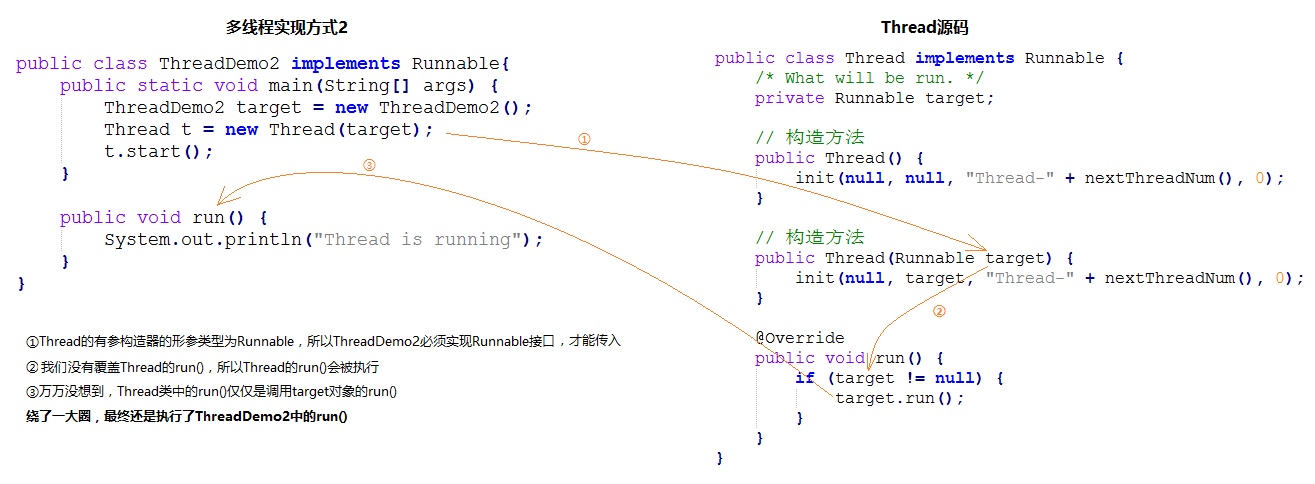
所以,該何如理解上面那兩句話呢?
reason 1
- 限定
Thread構造方法的形參類型(針對方式2implement Runnable)
把Runnable想成教派(形而上的教派),只有我大R家的人,才是一家人,一家人就是要整整齊齊。看看下面的代碼:
Runnable runnable = new RunnableExample();
Thread thread = new Thread(runnable);
// Thread's constructor
public Thread(Runnable target) {
init(null, target, "Thread-" + nextThreadNum(), 0);
}
thread.start();
- 首先,R家建立一個任務(task)叫作
runnable,任務內容寫在run()裡面 - 他派出手下的
Thread交給他這個task(使用constructor傳遞任務) - 手下的
Thread收到後先檢查是不是R家的任務,形參必須是Runnable或其底下家人才能收下 - 執行
thread.start()後將會調用Thread自家的run()方法
Thread的有參構造函數只允許接受Runnable的實現類對象,包括Thread子類對象
觀察源碼,我們發現Thread也實現了Runnable
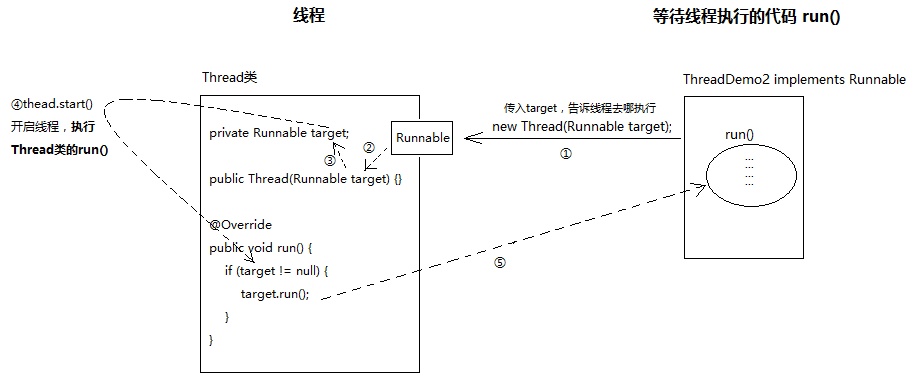
就像我先前說的,Thread這個家族入口很嚴格,只有身為Runnable宗族的人,才能進來的。
reason 2
- 將
run()向上抽取,做成抽象方法,讓實現類去重寫(為什麼?)
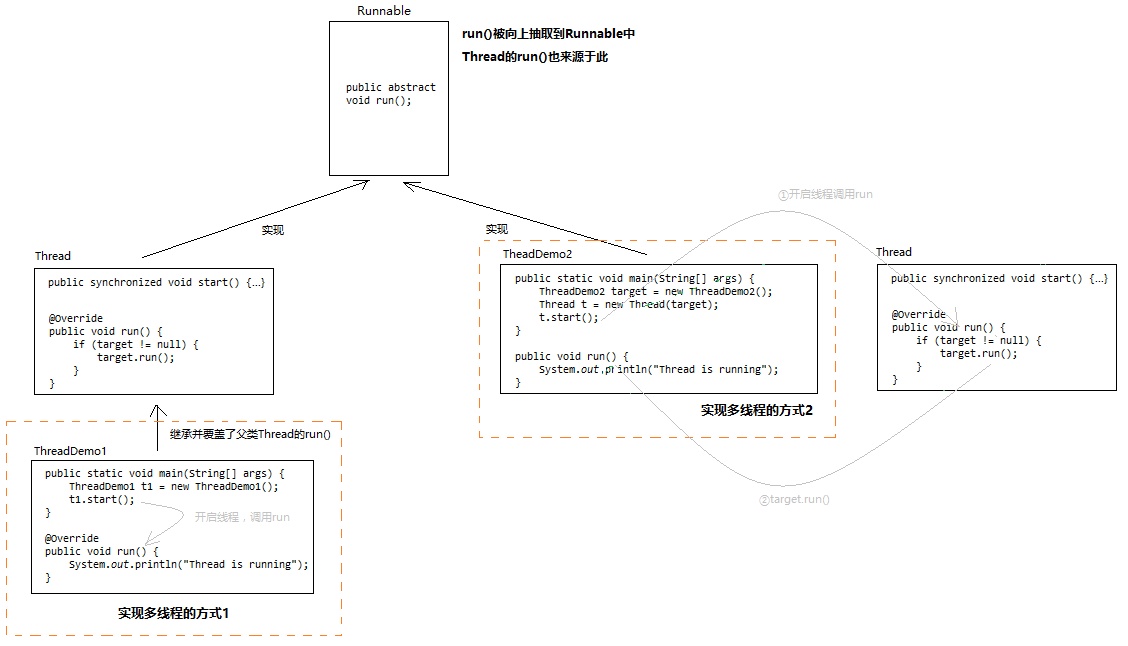
觀察上圖,可以發現:
- 一個線程運行,總是由
start()開始,因為它才是開啟線程的鑰匙,並且開始後JVM會調用run()方法執行
* Causes this thread to begin execution; the Java Virtual Machine calls the <code>run</code> method of this thread.
run()的本質只是為了”包裹”需要線程執行的代碼塊
* If this thread was constructed using a separate Runnable run object, then that Runnable object's run method is called;
*
* otherwise, this method does nothing and returns.
*
* Subclasses of Thread should override this method.
來解讀上面那段話:
如果這個線程由
Runnable建立,則調用Runnable對象的run方法;否則(如果是
Thread建立的線程),則override父類的run方法
結合圖片以及說明,可以發現在上編程時,執行線程的包裹只有黃色虛線框內的代碼,當線程被start()喚醒後,只會去調用Thread的run():
- 這個
run()可能來自Thread類(方式2) - 也可能來自
Thread的子類對象(方式1)
換言之,Thread類(及其子類)是線程運行的入口,沒了Thread以後,Runnable及其實現類(implement class)就無法調用run方法。
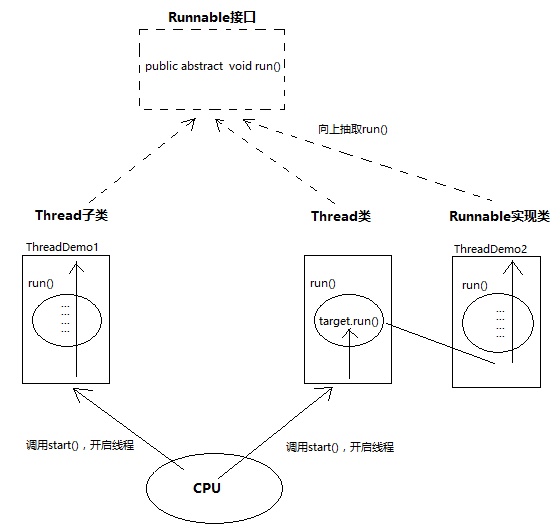
Thread类及其子类永远是入口,方式2写在Runnable实现类中代码之所以能被执行到,仅仅是因为Thread的run()中调用了target.run()。
Compare
所以說,該如何選擇呢?
-
通過
Thread類來擴展(extends)線程沒有充分運用面向對象的思想,因為一旦從Thead繼承了,就無法再繼承其他類(Java不允許多重繼承)。 -
如果遵循良好的設計規範,繼承(
extends)是用於擴展父類的功能,但是當我們創建線程時,我們不會去擴展Thread類的功能,而只是使用提供的run()方法的實現。 -
解耦執行者(
thread)與被執行者(run())兩者,將【待執行代碼】移到Runnable實現類中,達到【資源共享】的目的。
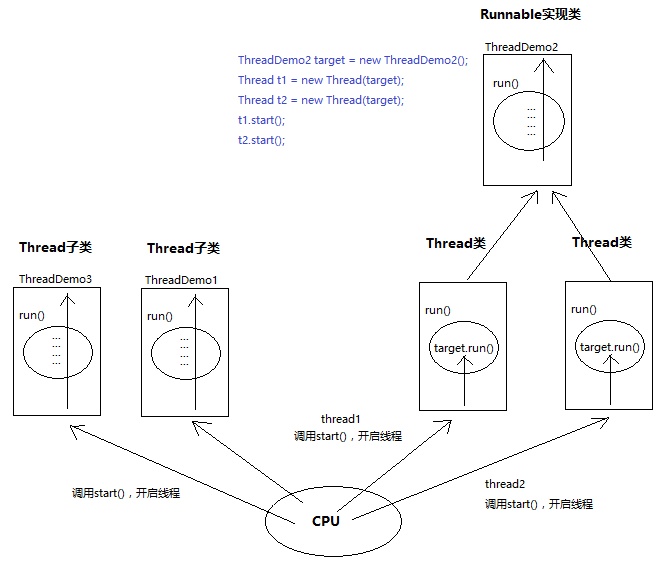
注意,继承
Thread方式並沒有做到资源共享,因为每个子类对象都有各自的一份run(),各玩各的。
多個線程共享資源:
public class ThreadForIncrease {
private static int cnt = 0; // public data
public static void main(String[] args) throws InterruptedException {
Runnable runnable = () -> {
int n = 10000;
while (n > 0) {
cnt++;
n--;
}
};
Thread thread1 = new Thread(runnable);
Thread thread2 = new Thread(runnable);
Thread thread3 = new Thread(runnable);
Thread thread4 = new Thread(runnable);
Thread thread5 = new Thread(runnable);
thread1.start();
thread2.start();
thread3.start();
thread4.start();
thread5.start();
Thread.sleep(1000);
System.out.println(cnt);
}
}
# Output
第一次執行:17727
第二次執行:16156
第三次執行:16290
第四次執行:15378
第五次執行:17358